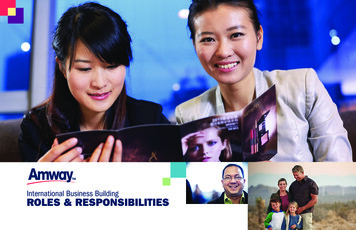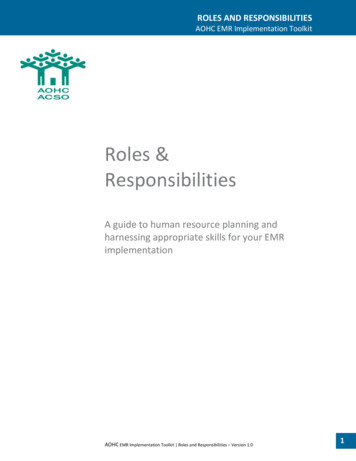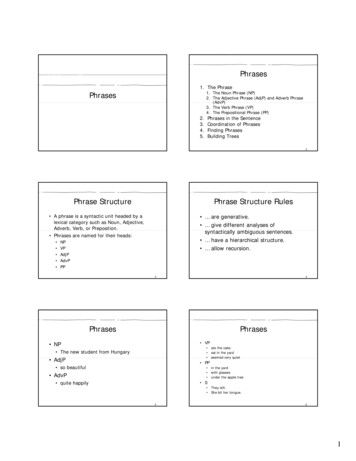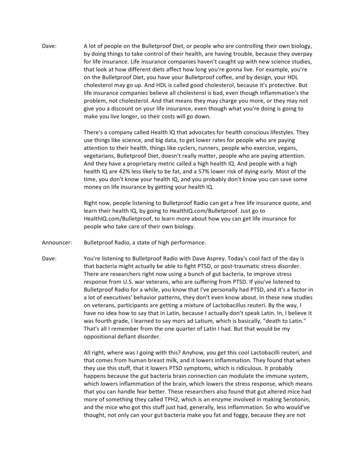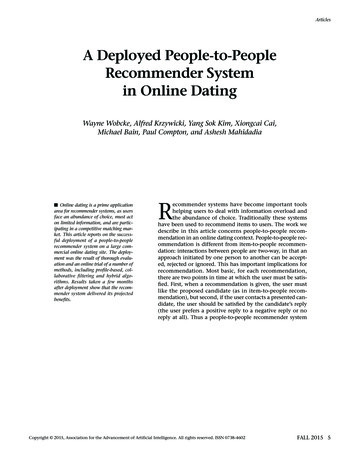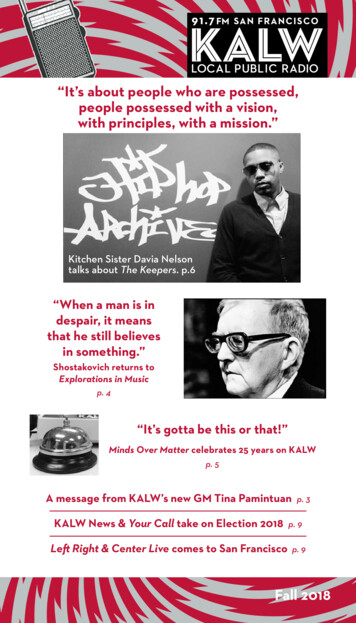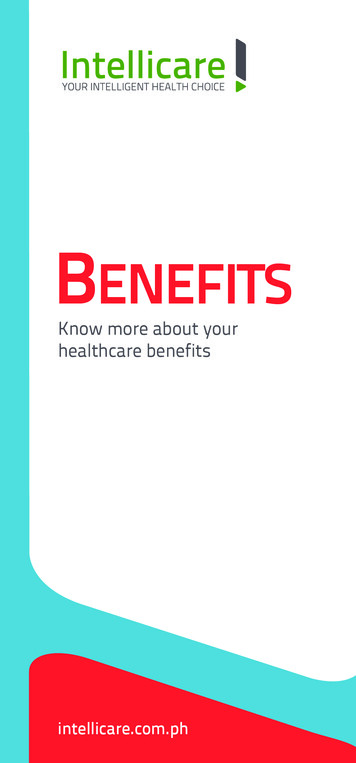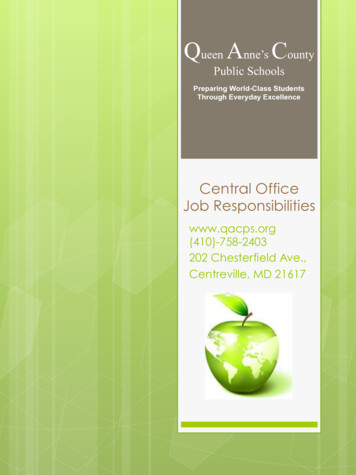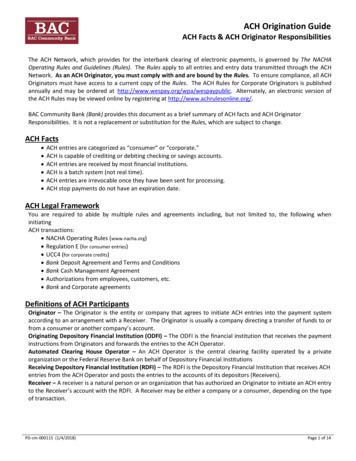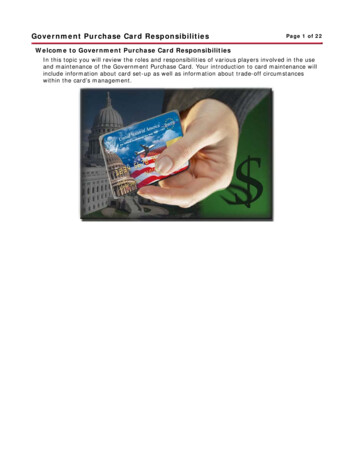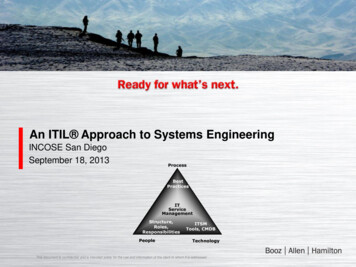
Transcription
An ITIL Approach to Systems EngineeringINCOSE San DiegoSeptember 18, re,Roles,ResponsibilitiesPeopleITSMTools, CMDBTechnologyThis document is confidential and is intended solely for the use and information of the client to whom it is addressed.
Introduction Timothy Rogers, IT Service Management andGovernance Expert at Booz Allen Hamilton Former CTO with 20 years’ experience spanninghigh-tech start-ups, financial services, and Federalgovernment sectors Holds Master's degree from UCSD, and certifications inITIL (v3 Expert), CMMI, COBIT, and Lean Six Sigma Author of “Ten Steps to ITSM Success: A Practitioner’sGuide to Enterprise IT Transformation” Speaker at itSMF USA/HDI Fusion and LEADit Australia *Interesting fact: Lived and worked in Hong Kong andspeaks some Mandarin Chinese2
Today’s Agenda PART I – Setting the Stage What is ITSM? What is ITIL? The Driver: Enterprise IT Transformation Industry and Government Examples PART II – Systems vs. Services Approach IT Service Management (ITSM) and ITIL – “It’s all About the Services” Traditional Systems Engineering – “System of Systems Approach” Key Similarities and Differences PART III – An ITIL Approach to Systems Engineering Marrying ITIL and Systems Engineering How Can You Help Your Organization Make the Transition? Recommendations and Next Steps Question & Answer3
Part I:SETTING THE STAGE4
What Is ITSM? ITSM is the Industry Acronym for Information Technology (IT) Service Management Is the Set of People, Process and Technology Used to Provision IT Services andManage IT Infrastructure in a Standardized, Repeatable, and Cost-Effective Manner ITSM is Practiced by All IT Service Provider Organizations, Whether Planned or Ad-Hoc Leading IT Organizations Differentiate Themselves by Demonstrating a High Level ofProcess Maturity and Continuous Improvement in the Delivery of Quality Services atOptimized re,Roles,ResponsibilitiesPeopleITSMTools, CMDBTechnology5
What Is ITIL? ITIL is the Industry Acronym for the Information Technology (IT) Infrastructure Library Predominant Global Standard for Managing and Improving Enterprise IT Performance Proven Framework of Best Practices that has Been Successfully Applied by Organizationsof All Sizes Across Industries (e.g. Company and Industry Agnostic) Adaptable to Each Organization Based on Strategic Needs and IT Process Maturity6
Big Picture: Enterprise IT Transformation DoN to reduce total IT spend 25% over 5 years via enterprise IT efficiencies Strategy – Shift from owning assets (CAPEX) to managing services (OPEX) How? – Enterprise data center consolidation, shared services, processes, etc 7
Example #1: Financial ServicesTransformation Objective: “Provision high-quality IT services atoptimal cost to business Users via a Single Enterprise Catalog.”(4) IndependentBusiness UnitsBroken ServiceModel*Multi-line Insurance Company Example8
Example #2: Department of Defense“The biggest technology transformation the Department’s ever done.”DoD CIO Principal Deputy Robert CareyJoint Information Environment (JIE)9
Part II:SYSTEMS VS. SERVICESAPPROACH10
Standards & Frameworks: “What to Do”IT ManagementFrameworksFramework DefinitionIT GovernanceFrameworksFrameworks that help organizations define and manageleadership and organizational structures and processesto ensure that the organization’s IT sustains andextends the organization’s strategies and objectives.IT ServiceManagement (ITSM)FrameworksFrameworks that help organizations develop andmanage the capabilities (people, process, informationtools) required to provision high quality IT services in astandardized, repeatable, and cost effective manner.Information SecurityManagement (ISM)FrameworksFrameworks that offer best practice recommendationson information security management, risks, and controlwithin the context of an overall information securitymanagement system (ISMS) that defines a set ofpolicies related to IT security and risks.IT ProjectManagement (PM)FrameworksFrameworks that provide standardized methodology,guidelines, rules, and characteristics for IT projectmanagement.Predominant(de facto)FrameworkRef: “Information Technology Management Frameworks: An Overview and Research Directions.”To be published by Dr. Bala, H. and Dr. Ramesh V. Indiana University11
Standards & Frameworks: “How to Do It”EnterpriseArchitecture(EA) Planning Execution InnovationSystemsEngineering Principles, Policies & Guidelines Interoperability, Agility, Reuse “System of Systems” Methodology Systems Engineering Management12
Systems vs. ServicesSystemINCOSE Definition:A combination of interacting elements organized to achieve one or more stated purposes.An integrated set of elements, subsystems, or assemblies that can accomplish a defined objective. Theseelements include products (hardware, software, firmware), processes, people, information, techniques,facilities, services and other support elements.Examples: Aircraft control system, server farm, operating systemServiceITIL Definition:A means of delivering value to Customers by facilitating Outcomes Customers want to achieve without theownership of specific Costs and Risks.Examples: Flight from A to B, E-mail, online banking13
Service Example: Flight to AustraliaDelighted Customer!Direct LinkSystem (in Design)Product (System in Operation)14Service
ITIL in Practice: The Service LifecycleITIL v3 Provides a Comprehensive Framework for Defining andManaging Services throughout the entire Lifecycle:15
The Service Design PackageITIL focuses on Service Design, Not Solution Development. . .Service Levels Service levels and costs agreeable betweencustomers and providers Overall quality requirementsCapacity Satisfy & scale with demand Forecasts, current & futuretechnologiesContinuity Recovery & continuity plans Consistent and timely deliveryAvailability Expected availability &reliability Sufficient accessibilitySecurity Protection against security breaches Justifiable & acceptable securityproceduresServiceDesignPackage?Supplier (Contracts) Contracted service aligned withrequirements Service levels not compromised byprovider performanceService Catalog Service definition & attributes Configuration items16
Systems Engineering in Practice:The Systems LifecycleWhile there is some overlap, the majority of core SystemEngineering activities are not addressed in ITIL. . .*Exogenous tothe ITIL frameworkRef: “Systems Engineering for Intelligent TransportationSystems,” United States Department of Transportation - FederalHighway Administration17
Key Similarities and DifferencesWhile there is some process overlap, several of the SystemsEngineering “Technical Processes” address areas ITIL does not. . .*** Broad OverlapKey ITIL Processor FunctionNot addressedin ITILe.g. ITIL “Whitespace”*Ref: INCOSE Systems Engineering Handbook v3.2.2, INCOSE,p. 218
Part III:AN ITIL APPROACH TOSYSTEMS ENGINEERING19
ITIL: It’s All About the ServicesITIL views everything in IT through a services lens (customer view)(2) Key ITIL Roles:Service OwnerBlue Service OwnerExample: E-MailAccountable and responsible for endto-end service performance across theenterprise*Orange Process OwnerExample: AvailabilityManagementProcess OwnerAccountable and responsible for endto-end process performance across theenterprise
ITIL View of the Infrastructure Systems and their components are viewed in aggregate as “the Infrastructure”, whichexists solely to support and enable service provisioning Infrastructure may be in-house, 3rd party, or shared (e.g. public cloud) and in all cases isviewed as elastic, not fixed or static. . .Service AService BService CService DSource: ITIL Service Transition, Office of Government Commerce, 2007, p.78.21Service E
The ITIL V-ModelITIL defines a “Services” V-Model as part of Configuration Mgmt. . .Source: ITIL Service Transition, Office of Government Commerce, 2007, p.78.22
The Systems Engineering V-ModelSystems Engineering and the role of the ITIL V-Model. . .23
Marrying ITIL System Engineering (1)Hierarchy of “V’s”. . .1ServicePortfolio2System ofSystems3Systems Components24
Marrying ITIL System Engineering (2)**Integrated Processes. . .Service Portfolio ManagementServiceStrategy*Demand ManagementFinancial Management*ServiceDesignServiceTransitionService Catalog ManagementService Level ManagementAsset ManagementKnowledge ManagementIncident ManagementServiceOperationsProblem ManagementRequest Fulfillment25
What’s a Systems Engineer To Do?So What is a System Engineer’s Role in an ITIL World? Recognize where ITIL processes support and enhance systemsengineering processes Leverage ITIL processes when defining, validating, and providingservices Utilize an ITSM/ITIL approach to encourage emphasis on stakeholderrequirement development Stakeholder requirement development often considered extraneousoverhead by IT managers when using a traditional system-ofsystems approach to IT developmentUtilizing ITIL is a BIG WIN forsystems engineers – helpssystems engineers efficientlydefine and provide IT services26
Recommendations and Next StepsHow Can You Help Your Organization Make the Transition? Understand where your organization is within the IT transformationprocess Identify the changes to your system that will be required to provide ITservices as your organization progresses through IT transformation Encourage shifting to an ITSM/ITIL approach for gathering and definingstakeholder requirements and providing a focus on the services27
In Conclusion: The Future is NowDoD is transitioning from a traditional waterfall systems acquisitionsapproach to a more agile approach to acquiring and managing services.Defense Science TaskForce on Improvementsto Service Contracting(All services, includingIT Services):Product: 158B (43%)Service: 212B (57%) IT services have completely permeated the national security enterprise. The DODis increasingly dependent on IT enabled services for both business enterprise andmission activities. As a result IT service reliability is directly related to DODbusiness and mission risk. DoD is facing 450 billion to 1 trillion in cuts over the next decade that will forceconsolidation to enterprise shared services including cloud computing. Shared enterprise services will require enterprise service management capabilitiesbeyond what currently exists or is budgeted for. The DOD currently acquires more service than product. DOD programs providemore service than product. Service acquisition extends through the period ofperformance, but current DOD capabilities are based on product and systemacquisition and are inadequate for managing the cost, quality, risk, performance,and mission outcomes related to service.Ref: “ITSM in the DoD” Presentation Dated 14 December 2011Presented by Bill Powell and Michael Thompson to the ISACA Virginia Chapter28
Big Picture: Enterprise IT Transformation DoN to reduce total IT spend 25% over 5 years via enterprise IT efficiencies Strategy – Shift from owning assets (CAPEX) to managing services (OPEX) How? – Enterprise data center consolidation, shared services, processes, etc 29
Change is Coming – Be Prepared!DoD Acquisition Lifecycle improvement plansPrograms and regulations to improve and accelerate the IT acquisitions processOffice of Management andBudget (OMB)25 Point Plan DC Consolidation (800/2015)IT Program Mgr. Career PathEnterprise shared servicesFederal Cloud First PolicyEliminate underperforming ITprojects Acquisition process for ITNational DefenseAuthorization Act (NDAA)of 2011 BPR required if development ormodernization funding exceeds 1M IT Management coordinationthrough updated EnterpriseArchitecture regulationsDefense BusinessCapability Lifecycle (BCL) Rapidly acquire and deliverbusiness IT capabilities Designed to enable deliveryof incremental capabilitieswhile requiring compliancewith business processrequirements Shortens cycle time toreduce waste whilemaintaining oversightRef: “ITSM in the DoD” Presentation Dated 14 December 2011Presented by Bill Powell and Michael Thompson to the ISACA Virginia Chapter30
?31
Thank You for Participating! An ITIL Approach to System Engineering Recommended Reading: Ten Steps to ITSM Success: APractitioner’s Guide to Enterprise IT TransformationContact details:Timothy RogersRogers Timothy@BAH.com(858) 356-7373Andy Haass, CSEPHaass John@BAH.com(760) 803-8029Chris Waskiewicz, CSEPWaskiewicz Christopher@BAH.com(619) 542-426432
Service Owner Process Owner enterprise . 21 ITIL View of the Infrastructure Source: ITIL Service Transitio
